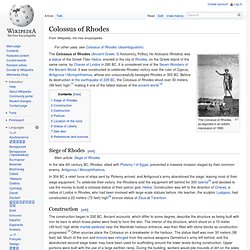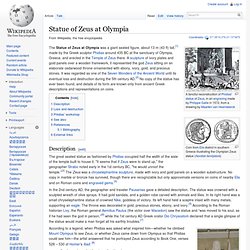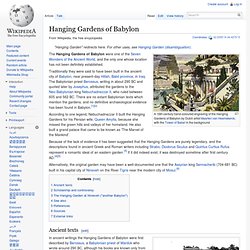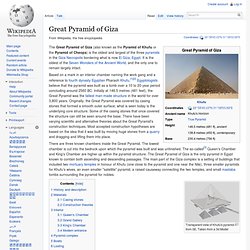

Lighthouse of Alexandria. The Lighthouse of Alexandria, sometimes called the Pharos of Alexandria (in Ancient Greek, ὁ Φάρος τῆς Ἀλεξανδρείας), was a lofty tower built by the Ptolemaic Kingdom between 280 and 247 BC and between 393 and 450 ft (120 and 137 m) tall. It was one of the tallest man-made structures on Earth for many centuries, and was regarded as one of the Seven Wonders of the Ancient World. Badly damaged by three earthquakes between 956 and 1323, it then became an abandoned ruin. Colossus of Rhodes. The Colossus of Rhodes, as depicted in an artist's impression of 1880.

Siege of Rhodes[edit] In the late 4th century BC, Rhodes, allied with Ptolemy I of Egypt, prevented a massive invasion staged by their common enemy, Antigonus I Monophthalmus. Construction[edit] The construction began in 292 BC. Ancient accounts, which differ to some degree, describe the structure as being built with iron tie bars to which brass plates were fixed to form the skin. Mausoleum of Halicarnassus. Scale model of a reconstruction of the Mausoleum, one of many widely differing versions, at Miniatürk, Istanbul This lion is among the few free-standing sculptures from the Mausoleum at the British Museum. The Mausoleum at Halicarnassus or Tomb of Mausolus[1] (Greek: Μαυσωλείο της Αλικαρνασσού, modern Turkish: Halikarnas Mozolesi) was a tomb built between 353 and 350 BC at Halicarnassus (present Bodrum, Turkey) for Mausolus, a satrap in the Persian Empire, and Artemisia II of Caria, who was both his wife and his sister. The structure was designed by the Greek architects Satyros and Pythius of Priene.[2][3] The word mausoleum has now come to be used generically for an above-ground tomb.
Conquest[edit] Halicarnassus[edit] Artemisia and Mausolus spent huge amounts of tax money to embellish the city. In 353 BC, Mausolus died, leaving Artemisia to rule alone. Artemisia lived for only two years after the death of her husband. Statue of Zeus at Olympia. Coordinates: The Statue of Zeus at Olympia was a giant seated figure, about 13 m (43 ft) tall,[1] made by the Greek sculptor Phidias around 435 BC at the sanctuary of Olympia, Greece, and erected in the Temple of Zeus there.

A sculpture of ivory plates and gold panels over a wooden framework, it represented the god Zeus sitting on an elaborate cedarwood throne ornamented with ebony, ivory, gold, and precious stones. Temple of Artemis. Coordinates:

Hanging Gardens of Babylon. The Hanging Gardens of Babylon were one of the Seven Wonders of the Ancient World, and the only one whose location has not been definitely established.

Traditionally they were said to have been built in the ancient city of Babylon, near present-day Hillah, Babil province, in Iraq. The Babylonian priest Berossus, writing in about 290 BC and quoted later by Josephus, attributed the gardens to the Neo-Babylonian king Nebuchadnezzar II, who ruled between 605 and 562 BC. There are no extant Babylonian texts which mention the gardens, and no definitive archaeological evidence has been found in Babylon.[1][2] According to one legend, Nebuchadnezzar II built the Hanging Gardens for his Persian wife, Queen Amytis, because she missed the green hills and valleys of her homeland. He also built a grand palace that came to be known as 'The Marvel of the Mankind'. Ancient texts[edit] Hanging Gardens of Babylon, 20th-century interpretation Scholarship and controversy[edit] Great Pyramid of Giza. The Great Pyramid of Giza (also known as the Pyramid of Khufu or the Pyramid of Cheops) is the oldest and largest of the three pyramids in the Giza Necropolis bordering what is now El Giza, Egypt.

It is the oldest of the Seven Wonders of the Ancient World, and the only one to remain largely intact. Based on a mark in an interior chamber naming the work gang and a reference to fourth dynasty Egyptian Pharaoh Khufu,[1][2] Egyptologists believe that the pyramid was built as a tomb over a 10 to 20-year period concluding around 2560 BC. Initially at 146.5 metres (481 feet), the Great Pyramid was the tallest man-made structure in the world for over 3,800 years. Originally, the Great Pyramid was covered by casing stones that formed a smooth outer surface; what is seen today is the underlying core structure. Some of the casing stones that once covered the structure can still be seen around the base.
There are three known chambers inside the Great Pyramid. History and description[edit] Seven Wonders of the Ancient World.